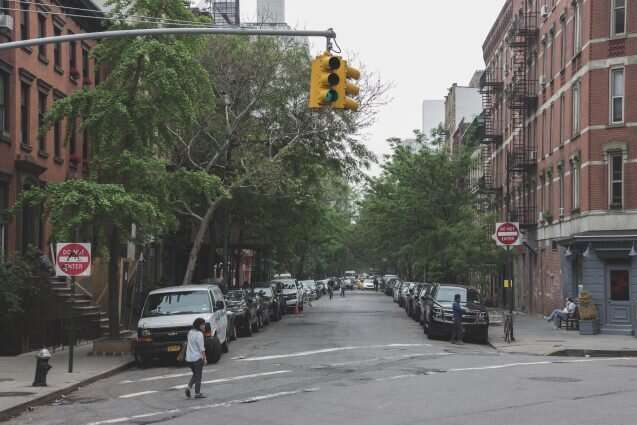How electric vehicle chargers can help make cities more equitable and resilient

The passage of recent legislation opens a unique window to build back from decades of inequities.
The US Infrastructure Investment and Jobs Bill provides $1.5 trillion of infrastructure funding, covering everything from lead pipe replacement to environmental remediation. The Inflation Reduction Act (IRA) allocates $60 billion specifically for environmental justice. Each contains ambitious goals that aim to address systematic inequalities, but whether, how, and when these goals will be met remains to be determined.
Cities stand as one of the most acute environments of injustice. Decades of redlining and racist policies have left many Black, Brown, Indigenous, and other marginalized communities living in dangerous environments that are disproportionately impacted by climate change. For example, the Mott Haven neighborhood in the South Bronx has suffered from decades of underinvestment in infrastructure and air quality controls. Today, Mott Haven has some of the worst air pollution levels in the country and abnormally high asthma rates. It's been nicknamed "Asthma Alley."
Urban communities are also plagued by transit deserts. Without ready access to public transportation options, communities are barred from education, employment, and health opportunities, creating a compounding insidious effect over time. Studies show a significant racial access gap in cities; BIPOC communities have less of an ability to reach jobs in a timely manner via public transit.
To meet the goals of the bills and truly "build back better," we need to attend to the centuries of systemic underinvestment plaguing marginalized urban communities. I believe that electric vehicles can be an important piece of this puzzle, complementing the expansion of public transportation networks—especially if chargers are distributed equitably.
Personal electric vehicles reach places that public transit can't. Electrification cleans local air, protecting health. Electric vehicles (EVs) save on fuel and maintenance, ultimately putting money back in the pockets of the owner and the entire community. While the upfront cost of EVs is prohibitively expensive for most, recent legislation will accelerate affordability. The IRA expands credits for new electric vehicle purchases, and institutes new credits for used EVs. It is a major step toward widespread EV adoption.
Another major step forward: The Jobs Bill allocates $7.5 billion to build an electric vehicle charging network to tackle range anxiety. If deployed right, this infrastructure can deliver the benefits of electric vehicles to all.
The question becomes, what are the right infrastructure investments to prioritize equity and resilience?
Curbside charging projects are an exciting first step. New York City installed 60 charging stations across its boroughs. These stations are accessible, less expensive than private charging options, and public. Still, standalone charging stations require extensive permitting and construction, making them both costly and time intensive. As such, the Department of Transportation is currently exploring additional innovative curbside charging options through its DOT Studio. One type of these solutions has already been deployed in Europe.
London launched a pilot converting 1,000 lampposts into chargers. Due to its widespread success, there are goals to expand the program to 50,000 lamppost charging stations across the country by 2025. Retrofitting existing infrastructure saved communities' money, time, and public space.
Whether done through standalone stations or retrofits, charging networks should be both ubiquitous and smart. Distributed public charging can tackle transit deserts, local air pollution, and expensive charging costs. And new smart technologies could allow networks to even better serve communities.
First, software in charging stations could make your electricity cheaper the longer you stayed parked. Managed charging integrations, in which software actively controls load and charging speed, reduce power demands by prioritizing off-peak hours. A managed charging project in Brooklyn showed a reduction of 45% of power demand, significantly reducing costs while ensuring reliability. By shifting demand from peak hours to times when cleaner, cheaper energy sources are producing electricity, managed charging can also incentivize renewable generation and clear the air. It can provide communities with a safer grid, more money in their pocket, and cleaner air to breathe.
Furthermore, new technology could allow your parked car to save your community during a blackout. Vehicle-to-grid (V2G) technologies allow electric vehicle batteries to send power back to the grid through bidirectional charging. As marginalized communities are most at risk for climate disasters, a distributed network of V2G chargers could turn local vehicles into backup generators, providing a community safety net in times of crisis.
Like managed charging, V2G can also provide financial incentives to the vehicle drivers. Drivers could earn revenue for giving energy back to the grid during costly peak hours, and only pull power at low-cost times. In Colorado, a bidirectional charger project allowed the city of Boulder to save $270/month while charging its fleet of vehicles, approximately equivalent to the monthly lease payment for popular EVs. Ultimately, getting paid to park your car could alleviate the cost burdens of electric vehicle ownership, allowing wider affordability across all communities.
This is only the beginning. Smart charging stations could one day come to the rescue with emergency call buttons. They could educate people with air quality data. They could empower the communities they call home. This is not a sci-fi dream; these resilient and equitable technologies exist today.
Building back better should not be limited to the COVID pandemic, or recent climate disasters. The Jobs Bill and the IRA must address the decades of underinvestment in frontline communities that need it most.
These decisions cannot be made in a silo; frontline community members must be central to the process to understand which solutions fit their unique needs. Without the community at the table, we risk perpetuating the inequities that exist today.
Ultimately, by prioritizing equity and resilience in decision-making today, we can achieve the true potential of this landmark legislation and build a better world for all.

















